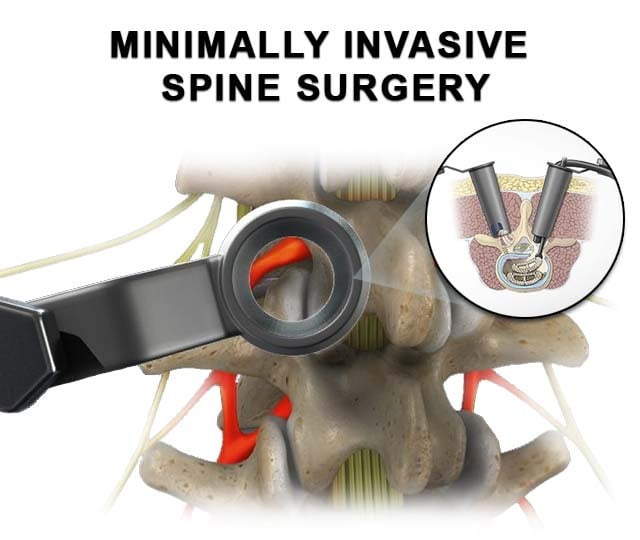Before the tremendous advancements made in minimally invasive spine surgery, your only option to relieve back pain was either taking dangerous opioids or facing open surgery that often left you with a long recovery and lingering side effects. Now you can find relief at a pain clinic near you at NYC pain management. Our pain specialists more often focus on non-invasive or less-invasive spine treatments to provide a number of safe, effective options.
The minimally invasive back surgery performed by our spine specialists is done on an outpatient basis, which allows you to recuperate at home. Don’t wait to seek help because you’re afraid of needing back surgery, call today for an evaluation and to learn your options.
At pain management clinic NYC, the first line of treatment is always the least invasive when combating acute or chronic pain. Following a thorough examination, your pain management doctor may order additional tests with the most advanced diagnostics in New York. Once the cause of your pain is determined, you may begin with conservative treatments, such as behavior modifications and over-the-counter medicine to alleviate your pain.
But if your pain lingers, the top pain clinic in Manhattan offers a wide range of treatments for back pain that include:
You may find pain relief from chronic back pain or muscle and joint pain with trigger point injections or nerve blocks. But when those treatments don’t fully resolve your discomfort, you can rely on the experience and skills of pain doctors who also provide safe and effective minimally invasive spine surgery procedures.
What is minimally invasive spine surgery?
 Minimally invasive spinal surgery (MISS) is a type of back surgery performed through small incisions. This less invasive type of spinal procedure is done with a specialized hollow tube known as a tubular retractor. The spine surgeon uses this tool to visualize and treat the targeted spine area. This results in less trauma being caused to the nearby muscles and surrounding tissue.
Minimally invasive spinal surgery (MISS) is a type of back surgery performed through small incisions. This less invasive type of spinal procedure is done with a specialized hollow tube known as a tubular retractor. The spine surgeon uses this tool to visualize and treat the targeted spine area. This results in less trauma being caused to the nearby muscles and surrounding tissue.When the tube-shaped tool is inserted into the small incision, it gently pushes aside the muscle and soft tissue, creating a tunnel to the problem area of the spine. This enables the spine surgeon to insert small tools through the retractor and work on your spine. During the entire minimally invasive spine surgery, a special operating X-ray is used (fluoroscopy) that provides the doctor with real-time images of your spine.
This less invasive back surgery technique gives your surgeon great precision to repair and treat the targeted area. Another advantage it has over standard surgery is less pain and faster recovery times after surgery. MISS can be used for various types of spine surgery.
What is minimally invasive spinal surgery used for?
The primary focus of minimally invasive spine surgery is to relieve the pressure that may be pushing on nerves in your back and to stabilize joints and the vertebrae in your spine. It’s important to note that MISS may not be a suitable treatment option for your individual situation. A thorough evaluation by a spine surgeon is needed to determine which type of surgery will be best for your specific needs.
Conditions that may end up requiring minimally invasive spinal surgery include:

What are the types of minimally invasive spine surgery?
Minimally invasive surgery techniques can be applied to various types of spine surgery. Our spine doctors have extensive experience with MISS procedures.
Most common types of back surgery we perform on a regular basis include:
- Spinal cord stimulator, often used to treat extensive nerve damage
- Lumbar discectomy, to remove herniated discs causing lower back pain
- Selective dorsal rhizotomy, to treat muscle spasms
- Kyphoplasty, for spinal compression fractures
- Sacroiliac joint fusion, which relieves lower back, hip, and pelvic pain
- MILD procedure, which resolves pain from a pinched nerve or lower back trauma
- Spinal stenosis surgery, also called a laminectomy, which creates room for nerves that have been compressed
- Vertiflex, another effective treatment for spinal stenosis
- Intrathecal pump, which delivers pain medication directly where it’s needed on a continual basis
- Discseel Procedure, to treat damaged spinal discs.
- Intracept Procedure, to interrupt the transmission of pain signals while preserving the spine’s structure
What happens during minimally invasive spine surgery?
Most of the time, the surgical procedures are performed in the New York pain control clinic offices. Depending on what part of the spine being treated, you may be given localized numbing with sedation or general anesthesia. During the minimally invasive back surgery, your vitals will be carefully monitored by your spine surgeon. Antibiotics may be given both before and after the procedure to help prevent infection.
The vertebra, nerves, and discs in your spine are located deep under your skin. To reach the damaged or diseased portion of your spine, your pain doctor relies on a fluoroscopy, which is like a live x-ray video machine. It shows real-time images that guide his movements as he performs the necessary procedure.
Soft tissues — like muscles and ligaments that are in the way — may be diluted instead of cut, which is done during more invasive open back surgery. For minimally invasive surgery, the incisions are tiny and only require a couple stitches.
If you need screws or rods to support your spine, your physician may use guidewires that run through your skin to slide the instrumentation into place. Accessing your spine from the side, especially for lumbar procedures, drastically reduces post-surgical pain. Instead of opening your chest to perform a thoracic procedure, multiple tiny incisions can provide sufficient access.
What are the benefits of minimally invasive spinal surgery?
The biggest benefit of minimally invasive spine surgery is that you don’t have to be hospitalized and suffer from being cut open. When performed by a skilled spine surgeon, the risks of complications are greatly reduced and you can go home shortly after the procedure. Other significant advantages include:
- Less blood loss, since incisions are so minor
- Little to no scarring, so you heal and look better afterward
- Much less muscle damage, since your muscles usually aren’t cut
- Less post-operative pain, requiring even less pain medication
- Minimized safety risks
- Less downtime
- Faster recovery
- Less physical therapy and rehab needed afterward
What are the risks of minimally invasive spine surgery?
As with any surgical procedure, there are certain possible risks. The risks of this less invasive spinal surgery include:
- Infection
- Nerve damage
- Excess bleeding
- Anesthesia complications
These risks may vary according to your general health, age, and the types of back surgery performed. You can greatly reduce your risks and side effects when you rely on the top New York pain management doctors.
Surgery, even minimally invasive surgery, is rarely the first treatment option offered by any doctor. But if you’re in pain, come visit Pain Management NYC. Whether you need surgery or not, you’re in capable hands. You’ll receive the most appropriate treatment for your condition, all the way up to surgery.

Boleslav Kosharskyy, MD, is a top-rated, best-in-class interventional pain management doctor. He is board-certified in Anesthesiology, Interventional Pain Medicine, and Palliative Care.
Dr. Kosharskyy is an Associate Professor of Anesthesiology and Rehabilitation Medicine at Albert Einstein Medical College. He’s also the Associate Medical Director of Pain Medicine and Director of Anesthesia for the Joint Replacement Center at Montefiore Medical Center and Albert Einstein Medical College.
He is an active member of the American Society of Anesthesiology (ASA), the American Society of Regional Anesthesia and Pain Medicine (ASRA), and the New York State Society of Anesthesiologists (NYSSA)
